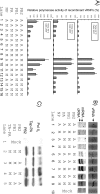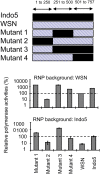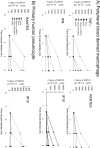Full factorial analysis of mammalian and avian influenza polymerase subunits suggests a role of an efficient polymerase for virus adaptation
- PMID: 19462010
- PMCID: PMC2680953
- DOI: 10.1371/journal.pone.0005658
Full factorial analysis of mammalian and avian influenza polymerase subunits suggests a role of an efficient polymerase for virus adaptation
Abstract
Amongst all the internal gene segments (PB2. PB1, PA, NP, M and NS), the avian PB1 segment is the only one which was reassorted into the human H2N2 and H3N2 pandemic strains. This suggests that the reassortment of polymerase subunit genes between mammalian and avian influenza viruses might play roles for interspecies transmission. To test this hypothesis, we tested the compatibility between PB2, PB1, PA and NP derived from a H5N1 virus and a mammalian H1N1 virus. All 16 possible combinations of avian-mammalian chimeric viral ribonucleoproteins (vRNPs) were characterized. We showed that recombinant vRNPs with a mammalian PB2 and an avian PB1 had the strongest polymerase activities in human cells at all studied temperature. In addition, viruses with this specific PB2-PB1 combination could grow efficiently in cell cultures, especially at a high incubation temperature. These viruses were potent inducers of proinflammatory cytokines and chemokines in primary human macrophages and pneumocytes. Viruses with this specific PB2-PB1 combination were also found to be more capable to generate adaptive mutations under a new selection pressure. These results suggested that the viral polymerase activity might be relevant for the genesis of influenza viruses of human health concern.
Conflict of interest statement
Figures






Similar articles
-
Mutations to PB2 and NP proteins of an avian influenza virus combine to confer efficient growth in primary human respiratory cells.J Virol. 2014 Nov;88(22):13436-46. doi: 10.1128/JVI.01093-14. Epub 2014 Sep 10. J Virol. 2014. PMID: 25210184 Free PMC article.
-
A statistical strategy to identify recombinant viral ribonucleoprotein of avian, human, and swine influenza A viruses with elevated polymerase activity.Influenza Other Respir Viruses. 2013 Nov;7(6):969-78. doi: 10.1111/irv.12117. Epub 2013 May 2. Influenza Other Respir Viruses. 2013. PMID: 23634764 Free PMC article.
-
Acquisition of Avian-Origin PB1 Facilitates Viral RNA Synthesis by the 2009 Pandemic H1N1 Virus Polymerase.Viruses. 2020 Feb 28;12(3):266. doi: 10.3390/v12030266. Viruses. 2020. PMID: 32121117 Free PMC article.
-
Adaptation of avian influenza A virus polymerase in mammals to overcome the host species barrier.J Virol. 2013 Jul;87(13):7200-9. doi: 10.1128/JVI.00980-13. Epub 2013 Apr 24. J Virol. 2013. PMID: 23616660 Free PMC article. Review.
-
Evolution and ecology of influenza A viruses.Microbiol Rev. 1992 Mar;56(1):152-79. doi: 10.1128/mr.56.1.152-179.1992. Microbiol Rev. 1992. PMID: 1579108 Free PMC article. Review.
Cited by
-
The avian-origin PB1 gene segment facilitated replication and transmissibility of the H3N2/1968 pandemic influenza virus.J Virol. 2015 Apr;89(8):4170-9. doi: 10.1128/JVI.03194-14. Epub 2015 Jan 28. J Virol. 2015. PMID: 25631088 Free PMC article.
-
The PB1 gene from H9N2 avian influenza virus showed high compatibility and increased mutation rate after reassorting with a human H1N1 influenza virus.Virol J. 2022 Jan 25;19(1):20. doi: 10.1186/s12985-022-01745-x. Virol J. 2022. PMID: 35078489 Free PMC article.
-
Identification of influenza polymerase inhibitors targeting C-terminal domain of PA through surface plasmon resonance screening.Sci Rep. 2018 Feb 2;8(1):2280. doi: 10.1038/s41598-018-20772-9. Sci Rep. 2018. PMID: 29396435 Free PMC article.
-
The influenza virus RNA polymerase as an innate immune agonist and antagonist.Cell Mol Life Sci. 2021 Dec;78(23):7237-7256. doi: 10.1007/s00018-021-03957-w. Epub 2021 Oct 22. Cell Mol Life Sci. 2021. PMID: 34677644 Free PMC article. Review.
-
Nationwide molecular surveillance of pandemic H1N1 influenza A virus genomes: Canada, 2009.PLoS One. 2011 Jan 7;6(1):e16087. doi: 10.1371/journal.pone.0016087. PLoS One. 2011. PMID: 21249207 Free PMC article.
References
-
- Murphy BR, Webster RG. Orthomyxoviruses. In: Knipes DM, Howley PM, editors. Fields Virology. 3rd ed. Lippincott-Raven Publishers; 1996. pp. 1397–1445.
-
- Taubenberger JK, Reid AH, Krafft AE, Bijwaard KE, Fanning TG. Initial genetic characterization of the 1918 “Spanish” influenza virus. Science. 1997;275:1793–1796. - PubMed
Publication types
MeSH terms
Substances
Grants and funding
LinkOut - more resources
Full Text Sources
Medical
Miscellaneous

